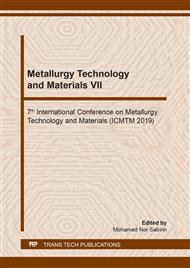p.94
p.100
p.106
p.111
p.116
p.121
p.128
p.135
p.141
Two-Stage Agitation Leaching of Old Flotation Tailings
Abstract:
The goal of the present work was to develop hydrometallurgical approaches based on acid leaching for selective extraction of base metals from the sample of old flotation tailings as well as obtaining solution, which can be used for leaching of substandard copper-zinc concentrate. Old flotation tailings contained 23.2% of iron, 0.36% of copper, and 0.23% of zinc. Copper-zinc concentrate contained 23.8% of iron, 16% of copper, and 5.3% of zinc. Agitation leaching of old flotation tailings with distilled water and sulfuric acid solutions (of 0.5 to 10% H2SO4) for 3 h at pulp density of 20% made it possible to extract of 26 to 34% and of 58 to 70% of copper and zinc, respectively. Concentrations of copper and zinc in the pregnant solutions were of 0.19 to 0.25 g/L and of 0.27 to 0.32 g/L, respectively. The increase in H2SO4 concentration up to 10% did not lead to significant increase in base metals extraction but led to significant increase in iron ions concentration in the pregnant solutions. Pregnant solution obtained during the leaching with water contained less than 1 g/L of iron ions, while that obtained during the leaching with 10% sulfuric acid contained about 9 g/L of iron ions. Therefore, two-stage acid leaching with water and 10% sulfuric acid was proposed for selective extraction of non-ferrous metals in the first stage and obtaining of ferric iron solution in the second stage. Two-stage leaching at pulp density of 40% with water made it possible to extract 31 and 64% of copper and zinc, respectively. It was shown, that second stage did not allow to increase non-ferrous metals extraction but made it possible to obtain solution containing 11g/L of ferric iron. This pregnant solution was used for oxidative leaching of copper-zinc concentrate. Leaching at 80°C made it possible to extract 13 and 48% of copper and zinc, respectively.
Info:
Periodical:
Pages:
116-120
Citation:
Online since:
October 2019
Authors:
Price:
Сopyright:
© 2019 Trans Tech Publications Ltd. All Rights Reserved
Share:
Citation:


